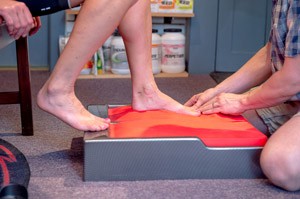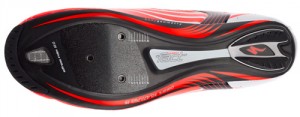How Should a Well Fit Cycling Shoe Feel and Other Considerations
How should a well fit cycling shoe feel? Not as many riders think. In many ways, a properly fit cycling shoe should fit much like a properly fit daily shoe.
- A well fit cycling shoe should be snug in the heel with even pressure on the instep.
- You should not be pressed against the end. You should have a little toe room at the end of a well fit cycling shoe and the shoe should hold your forefoot stable without pinching or restricting.
- You should not have large areas of gapping or folds in the material in a well fit cycling shoe.
- The ball of your foot should lie at the widest portion of the shoe to allow for proper cleat positioning within the shoe’s adjustment range in a well fit cycling shoe.
- Your foot should be stable and neutral in a well fit cycling shoe. This is a little different than a daily shoe for many riders, but a custom cycling footbed is often required to achieve proper alignment, ideal power transmission, and support in a cycling shoe for most riders.
When finding a w ell fit cycling shoe, remember that performance and comfort enhancing custom footbeds take up more room than most stock insoles and it is always good to have enough room for them. Buy comfortably snug, but don’t buy overly tight cycling shoes expecting them to stretch. While a small amount of width stretch is possible in some shoes and materials, the length of the shoe should not be expected to change with time.
ell fit cycling shoe, remember that performance and comfort enhancing custom footbeds take up more room than most stock insoles and it is always good to have enough room for them. Buy comfortably snug, but don’t buy overly tight cycling shoes expecting them to stretch. While a small amount of width stretch is possible in some shoes and materials, the length of the shoe should not be expected to change with time.
Do cycling shoes come in widths? Yes. One reason we carry brands like Sidi and D2 are because they are committed to making distinct widths and lasts (narrow, standard and wide) in some or all of their models to fit all shapes of feet. Don’t suffer by being in the wrong last for your foot shape thinking that there are not options in cycling shoes! There are options and very good ones at that.
What about foot support? Just like in a ski boot, proper foot support in a cycling shoe is crucial to maximizing performance, comfort and injury prevention through improved alignment and more even contact between the foot and the shoe. Most cycling shoes are fairly flat on the bottom and have stock insoles that offer little to no support. Learn more about custom cycling footbeds and consider having a pair made before you choose your new shoes as they can drastically improve a shoes performance and feel.
Why are some s hoes $60 and some $500? Fit, materials, features and quality of workmanship. The more expensive shoes are designed and built by craftspeople and simply fit and feel the best to most riders. High quality materials (like leather and Lorica), stiff soles, ratcheting buckles and replaceable parts all cost more to produce but add greatly to the long-term durability, performance and quality of fit of a shoe.
hoes $60 and some $500? Fit, materials, features and quality of workmanship. The more expensive shoes are designed and built by craftspeople and simply fit and feel the best to most riders. High quality materials (like leather and Lorica), stiff soles, ratcheting buckles and replaceable parts all cost more to produce but add greatly to the long-term durability, performance and quality of fit of a shoe.
Shoes under $100 are not designed for performance cyclists. They are designed for light use, often where walking comfort is as important as riding. Shoes in the $150 range will be of reasonable quality and are designed for low to moderate mileage riders looking to enhance performance beyond what the walking/cycling shoes offer. Shoes from $170-$300 are often excellent values built with many top end features like ratcheting buckles, high quality materials and built to very high standards. $300+ shoes have all that technology can currently offer with features like ultra-light carbon fiber soles, micro-adjustable buckles, additional straps for retention, the highest quality materials and most refined last shapes technology can offer. Choose according to how the shoe fits and your intended use. Spending an extra $100 now can make your feet much happier and can keep you from having to buy another pair next year.
 What about carbon fiber soles? The first thing to realize that is that just being carbon fiber is not enough. Carbon fiber come in many different quality grades. Generally, the higher the grade of carbon fiber, the stiffer the sole becomes. This can help with power transmission, but can also sometimes contribute to some problems as well. Carbon soles can sometimes be so stiff that they do not flex enough to absorb the weight and force of the rider’s body. This has contributed to an increase in the rate of painful injuries like plantar fasciitis for some riders. Using a really stiff sole without additional foot support is a lot like running on pavement barefoot – after awhile it can hurt. How can you reduce your risk?
What about carbon fiber soles? The first thing to realize that is that just being carbon fiber is not enough. Carbon fiber come in many different quality grades. Generally, the higher the grade of carbon fiber, the stiffer the sole becomes. This can help with power transmission, but can also sometimes contribute to some problems as well. Carbon soles can sometimes be so stiff that they do not flex enough to absorb the weight and force of the rider’s body. This has contributed to an increase in the rate of painful injuries like plantar fasciitis for some riders. Using a really stiff sole without additional foot support is a lot like running on pavement barefoot – after awhile it can hurt. How can you reduce your risk?
1) Have a custom cycling footbed made to keep your foot from over-flexing and potentially injuring itself on an overly stiff sole.
2) Consider a shoe with a multi-stiffness sole that is not unilaterally stiff across the whole sole. One reason we often recommend Sidi is that they use a bi-injected carbon soles in many models. Bi-injection mixes a more forgiving carbon in the sole to provide a bit more flex in peripheral areas of the the sole to protect the rider’s foot while still maximizing the torsional stiffness and responsiveness of the shoe. Power transmission is great, but not at the expense of injury or soreness.
Have questions? Want help finding the best shoes and cycling footbeds for your individual needs? Contact us for an appointment discuss shoes and pedal systems in more detail or to order.
